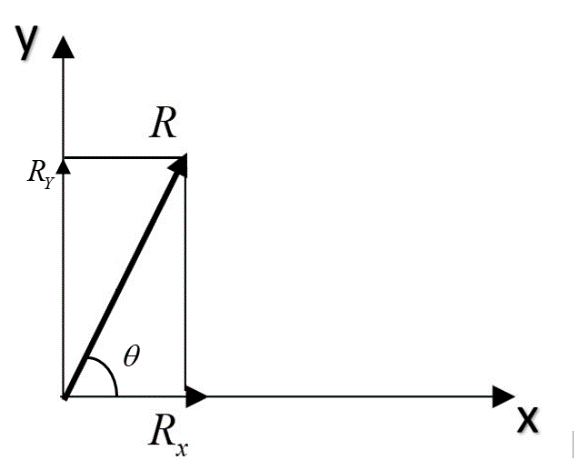
What do you mean by rectangular components of a vector? Explain how a vector can be resolved into two rectangular components in a plane.
Answer
432.2k+ views
7 likes
Hint: There are majorly two types of quantities, scalar and vector quantities. All the quantities are divided into these two categories. Scalar quantities are those quantities, which have only magnitude eg – mass, speed, pressure, etc. Vector quantities are those which have both magnitude and directions eg – weight, velocity and thrust. The special fact about vectors is that we can resolve it into components.
Complete step by step answer:
Rectangular components means the components or parts of a vector in any two mutually perpendicular axes. This could be understood by an example as illustrated below.

Let a vector quantity ‘R’ inclined at an angle
Additional Information: For any two general vectors, we have the magnitude of their resultant
Here A =
Hence, putting in the formula:
As
Also,
So,
Hence proved.
Note: One must not confuse that we can take the vector components only along axes that are mutually perpendicular. One can also find the component of a vector about any axis which inclination with the vector is given, provided the magnitude of the vector must not change.
Complete step by step answer:
Rectangular components means the components or parts of a vector in any two mutually perpendicular axes. This could be understood by an example as illustrated below.

Let a vector quantity ‘R’ inclined at an angle
Additional Information: For any two general vectors, we have the magnitude of their resultant
Here A =
Hence, putting in the formula:
As
Also,
So,
Hence proved.
Note: One must not confuse that we can take the vector components only along axes that are mutually perpendicular. One can also find the component of a vector about any axis which inclination with the vector is given, provided the magnitude of the vector must not change.
Latest Vedantu courses for you
Grade 10 | MAHARASHTRABOARD | SCHOOL | English
Vedantu 10 Maharashtra Pro Lite (2025-26)
School Full course for MAHARASHTRABOARD students
₹31,500 per year
Recently Updated Pages
Master Class 11 Economics: Engaging Questions & Answers for Success

Master Class 11 Business Studies: Engaging Questions & Answers for Success

Master Class 11 Accountancy: Engaging Questions & Answers for Success

Master Class 11 English: Engaging Questions & Answers for Success

Master Class 11 Computer Science: Engaging Questions & Answers for Success

Master Class 11 Maths: Engaging Questions & Answers for Success

Trending doubts
State and prove Bernoullis theorem class 11 physics CBSE

What are Quantum numbers Explain the quantum number class 11 chemistry CBSE

Write the differences between monocot plants and dicot class 11 biology CBSE

1 ton equals to A 100 kg B 1000 kg C 10 kg D 10000 class 11 physics CBSE

State the laws of reflection of light

One Metric ton is equal to kg A 10000 B 1000 C 100 class 11 physics CBSE




